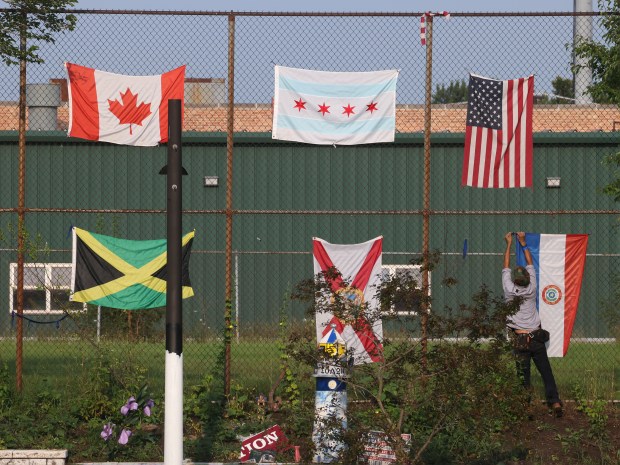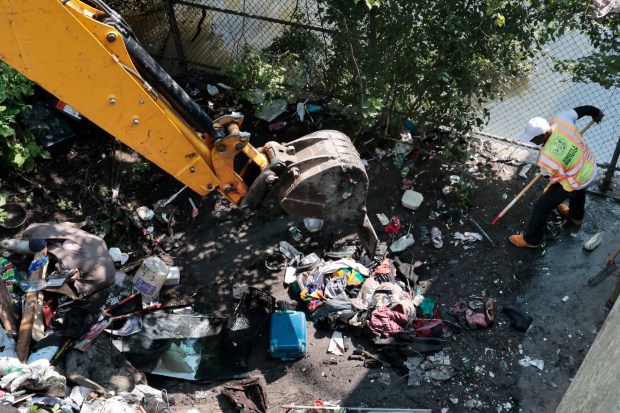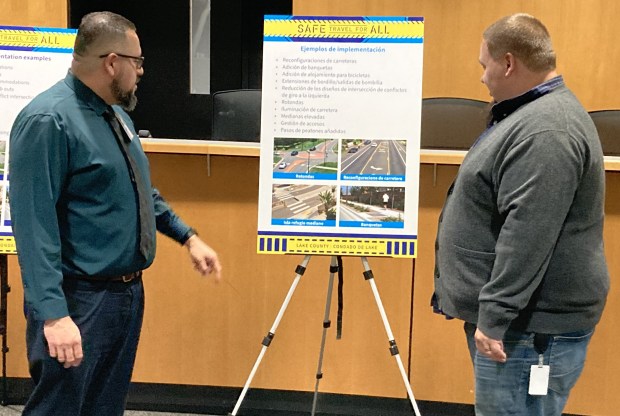Robert Bulanon, 52, has decorated his home along the North Shore Channel with items that others have thrown away. National flags of six different countries, colorful pinwheels, patterned rugs and vases.
Above the entrance to his tent hangs a large poster from a bank’s down payment assistance program that reads, “Dreaming of Homeownership?”
When city workers arrived early Tuesday morning to clear the tent encampment where Bulanon has lived for over six months, he knew he’d have to leave most of his belongings behind. He had refused offers to relocate to downtown city-run shelters, and now didn’t know where he would spend the night, he said.
“I said I’m not going downtown,” Bulanon said. “Downtown they’ll put me in an apartment for a month, but then what?”
Approximately 17 unhoused people were identified by the city as living in makeshift shelters along the North Shore Channel near Bryn Mawr Avenue in the North Park neighborhood. The cleaning and complete fencing-off of the site began Tuesday morning, with the city using river barges and bulldozers to clear belongings from under the bridge. Six residents still remained on-site Tuesday morning, city officials said.
Advocates for the homeless say the only solution for homelessness is permanent housing. If it cannot be offered, they say the homeless should be left in their makeshift shelters until it can be provided, Doug Schenkelberg, executive director of the Chicago Coalition for the Homeless, previously told the Tribune.
But the encampment has become the subject of controversy due to numerous propane tank fires and its proximity to Northside College Preparatory High School, a selective enrollment high school that is separated from the tents only by a tall wire fence.
“Community members were concerned because they come through here all the time. … We have a school right here, we have folks that are driving and walking on the bridge,” said Ald. Samantha Nugent, 39th, who was present at the encampment as the demolition began. “Also, it’s not safe for (encampment occupants) to be down there, and we want them to get housing.”
Nugent said she had received increasingly frequent complaints from North Park residents regarding their safety concerns. The site surrounding the Bryn Mawr Avenue bridge is also set to undergo riverbank restoration, which will involve heavy machinery, according to the Department of Family and Support Services.
However, the city’s move to shut the site down was also motivated by its larger Summer Encampment Initiative, according to the DFSS. The program’s objective is to remove people from tent encampments and relocate them to official shelters.
Accordingly, the clearing of the North Shore Channel encampment is not the first of its kind this month. On July 17, city workers cleared a major tent city near the Dan Ryan Expressway and fenced off the now-vacant dirt lot.
Case workers from the DFSS have offered to connect all displaced tent city occupants to shelter beds in the city, though some have refused placement. Many have been funneled to one particular shelter at the former site of the Tremont Hotel near the Magnificent Mile, where the city has made space available for people from the two shuttered encampments.
The city has targeted five different encampments across the city for placement at the Tremont, although the Bryn Mawr and Dan Ryan Expressway sites are the only to have been closed down so far. Mayoral spokesman Cassio Mendoza said that no additional encampment clearings are currently planned.
Outreach at the Bryn Mawr encampment regarding the impending shutdown began on June 15, according to the DFSS. In addition to shelter placement, occupants have also been offered substance abuse treatment, mental health services and case management, the city said.
Out of the total 17 residents, 11 have been placed at the Tremont shelter. Six declined housing, though beds at the Tremont are still available if they change their mind, DFSS Managing Deputy Commissioner Maura McCauley confirmed.
“The (DFSS) is here at the Bryn Mawr encampment site to support unhoused residents move to shelter so they can be connected to essential support services and housing opportunities,” the Department of Family and Support Services wrote in a statement. “DFSS believes a housing-first approach is the most effective way to tackle homelessness.”
Those being displaced from the tent city do not need to show any documentation of their immigration status to be connected with shelter, McCauley said.

However, this message had not been made clear to Sabrina Soto, who dragged a suitcase out from below the bridge as city officials flocked on the street above and bulldozers began to descend the hillside.
She had been living in the encampment for five months, she said. Though she had heard that shelter opportunities were being offered, she believed incorrectly that she was not eligible due to a lack of identifying documentation. Now she wasn’t sure where to head next.
“I didn’t have time to get my things,” Soto said. “They got put in the garbage.”
In the water below, a barge had maneuvered to fit under the bridge, allowing city workers to access the harder-to-reach areas of the encampment. Someone’s mattress floated in the water next to it.
Though the cleaning of the site began at around 9 a.m. on Tuesday, the city said it is not set to be completed until Wednesday.
As the clearing of the encampment began in full force, Bulanon continued to gather his things, moving along the wire fence separating the river from Northside College Preparatory High School.
Two officers from the Chicago Police Department and DFSS case worker Valerie Doatch went over to Bulanon’s tent to tell him once again to evacuate the premises. Doatch said that their goal was to “try to get him to comply and to offer services,” adding that they had tried to connect him to shelter for over a year.
Yet after the encounter, Bulanon said that he had again refused what he saw as only a temporary solution. If they had really intended to help, he said, they would have given him “a bottle of water or a piece of bread.”
“We’re the poorest people in the wealthiest country in the entire world,” Bulanon said. “We eat garbage, we live in the garbage.”




